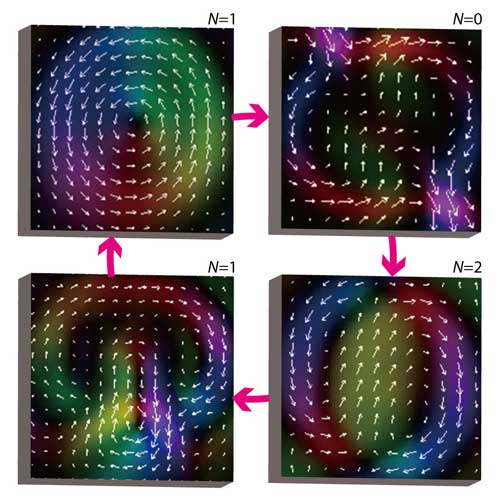| Posted: Feb 03, 2017 |
Magnetic bubbles pop up
(Nanowerk News) A team at RIKEN has been squashing, moving and popping an unusual breed of magnetic bubbles in the hope that these structures could eventually be used as information carriers in a new form of low-power computing (Advanced Materials, "Variation of topology in magnetic bubbles in a colossal magnetoresistive manganite").
|
|
These magnetic bubbles contain electron spins, which give rise to a magnetism akin to that of a bar magnet. In certain materials, an external magnetic field can shape the orientation of electron spins to generate stable, swirling patterns called skyrmions. The electron spins around the edges of these flat, circular vortices point in the same direction as the external field, while those at the center point in the opposite direction.
|
 |
| Figure 1: Applying an external magnetic field to skyrmionic bubbles deforms their walls and manipulates their topological number (N) in the order indicated by the pink arrows. (© WILEY-VCH Verlag)
|
|
Skyrmions are tiny, typically measuring a few nanometers across. The underlying atomic structure of the material determines whether they swirl clockwise or anticlockwise. But in some magnetic materials they can grow much larger and form ‘skyrmionic bubbles’ that have rather different properties.
|
|
Xiuzhen Yu of the RIKEN Center for Emergent Matter Science and colleagues have studied skyrmionic bubbles in very thin slices of a crystalline, ferromagnetic material called lanthanum strontium manganite.
|
|
They used an electron-microscopy imaging technique that employs a beam of electrons to image the texture of magnetization patterns within a material. This enabled them to watch how skyrmionic bubbles behaved as the external magnetic field or temperature was varied.
|
|
When lanthanum strontium manganite was cooled to -83 degrees Celsius without a magnetic field, narrow striped patterns appeared in the material’s magnetization. Cooling the material further and applying a magnetic field made some of these stripes transform into skyrmionic bubbles about 100 nanometers across, which remained even when the magnetic field was switched off.
|
|
The skyrmionic bubbles could swirl either clockwise or anticlockwise, independently of the underlying atomic structure. The bubbles also had diverse internal structures—some had cores that were not much larger than a normal skyrmion, surrounded by a thick ‘wall’ of opposing magnetic moments that completely isolated the core.
|
|
Applying a low magnetic field caused the skyrmionic bubbles to move, disrupted their walls or deformed them in various ways (Fig. 1). In some cases, the field created complex structures containing two skyrmionic bubbles with opposing swirls (bottom right in Fig. 1).
|
|
These fundamental investigations are a critical step toward developing applications for skyrmionic bubbles. “The minute magnetic bubbles emerge at zero field.” says Yu. “Such skyrmionic bubbles are promising for high-density, low-power magnetic memories.”
|
|
The team is trying to manipulate the bubbles using an electrical current composed of electrons with aligned magnetic moments, which could offer a more convenient method of control.
|

